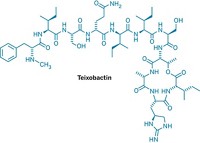Advertisement
Grab your lab coat. Let's get started
Welcome!
Welcome!
Create an account below to get 6 C&EN articles per month, receive newsletters and more - all free.
It seems this is your first time logging in online. Please enter the following information to continue.
As an ACS member you automatically get access to this site. All we need is few more details to create your reading experience.
Not you? Sign in with a different account.
Not you? Sign in with a different account.
ERROR 1
ERROR 1
ERROR 2
ERROR 2
ERROR 2
ERROR 2
ERROR 2
Password and Confirm password must match.
If you have an ACS member number, please enter it here so we can link this account to your membership. (optional)
ERROR 2
ACS values your privacy. By submitting your information, you are gaining access to C&EN and subscribing to our weekly newsletter. We use the information you provide to make your reading experience better, and we will never sell your data to third party members.
Biological Chemistry
Frog mucus peptide kills flu virus
Biomolecule breaks the H1 influenza virus apart without hurting human cells, making it a promising antiviral candidate
by Sarah Everts
April 24, 2017
| A version of this story appeared in
Volume 95, Issue 17
The slimy mucus that coats the skin of an Indian frog contains peptides that destroy the H1 influenza virus, according to a team of researchers led by Joshy Jacob of Emory University. One of these flu-killing peptides appears to be harmless to human cells, making it a promising antiviral candidate to fight the flu (Immunity 2017, DOI: 10.1016/j.immuni.2017.03.018). The slimy surface of Hydrophylax bahuvistara and other amphibians could become a siren call for researchers searching for antimicrobial compounds. The mucus contains many molecules that protect the animals against bacterial and viral pathogens, and the slime is relatively easy to isolate: Researchers need to just give the frogs a small electric shock, collect the released mucus, and let the amphibians hop away. Jacob’s team focused on one 23-amino-acid peptide, which the researchers named urumin after a deadly whip sword found in the same region as the frog’s native habitat. Most antiviral drugs interfere in a biological process such as replication or infection; urumin appears to smash the viral capsid to smithereens.





Join the conversation
Contact the reporter
Submit a Letter to the Editor for publication
Engage with us on Twitter